Ocean Winds Survey - Installment #4 - 22 February 2010
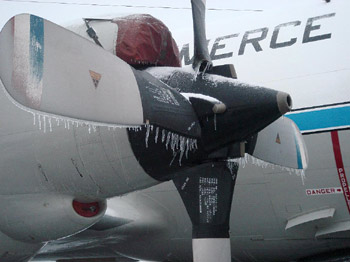 This is the final update of the Ocean Winds winter 2010 field
experiment. We conducted two consecutive flights Sunday (2/14) and
Monday (2/15) into a predicted hurricane force storm in the Atlantic
south of St. John's. On Sunday the storm was a little further south than
forecast so we weren't able to fully sample the southern portion of the
storm as originally planned. However, we did find marginal hurricane
force winds. One nice thing about this flight was that for the most part
we were free of precipitation and could visually see the ocean surface.
This is the final update of the Ocean Winds winter 2010 field
experiment. We conducted two consecutive flights Sunday (2/14) and
Monday (2/15) into a predicted hurricane force storm in the Atlantic
south of St. John's. On Sunday the storm was a little further south than
forecast so we weren't able to fully sample the southern portion of the
storm as originally planned. However, we did find marginal hurricane
force winds. One nice thing about this flight was that for the most part
we were free of precipitation and could visually see the ocean surface.
On Monday the storm had moved so that it was more to the east-southeast
of St. John's. We found the strong storm-force winds that we were
expecting, but the region of storm-force winds was significantly larger
than the forecast models were predicting. Both flights were excellent
data flights. For Sunday's flight we did have to de-ice again which did
surpass our previous de-icing bill and totaled about $25K. During the
final third of Monday's flight we did lose the radar return from both
channels of the C-band portion of IWRAP. We did some debugging during
the final portion of the flight. The calibration pulse and noise floor
appeared normal for both channels so we focused our efforts on the power
amplifier box. We made some power measurements with the power meter to
try ascertain where the problem might be. However, there wasn't enough
time track down the problem that day so we opted to take a few collected
data files to examine back at the hotel.
The following day (Tuesday) was
a hard-down day and most of the crew decided to try their hand at
curling. We rented two sheets of ice at the St. John's curling club for
a few hours and had a blast. The following day we went back out to the
plane to dig a little deeper into the IWRAP C-band issue. We had a final
flight planned for Thursday into the Labrador Sea area to fly some
calibration patterns in a large consistent area of gale force winds
associated with a passing storm. This flight was also coordinated with
an Oceansat2 overpass as was Monday's flight. With IWRAP we found that
the cable going from the power amplifier to the antenna had worked its
way loose at the rotary joint. There appeared to be a bracket that was
preventing the tightening of the connector so we opted to remove the
bracket.
When we showed up Thursday morning for our last flight, N43 was
a little bit of a popsicle. Three days of rain and fog with temperatures
hovering just around freezing was not a good thing. $44K later "Miss
Piggy" was looking much happier, but of course after $44K she had better
be happier! The two things that made us feel a little better about the
cost were that we would need to get rid of that ice eventually to go
home in a few days (temperatures were not forecast to rise) and that the
Air Force C-130 ahead of us spent $58K to de-ice. It was also great data
flight with the Oceansat2 overpass and the calibration flight patterns.
We still had problems with the C-band side of IWRAP. It turns out that
rotary joint failed structurally, which might have been helped along by
the removal of the bracket that was preventing us from fully tightening
the RF cable connector.
The flight otherwise went off without a hitch and we planned for a
pack-out data on Friday and a departure for Tampa on Saturday. However,
during the flight back to St John's a small section of de-lamination in
the co-pilot's window was noticed. The P-3 was subsequently downed until
repair which meant at least a week delay in departure. On Friday, plans
were made to send most of the crew home via commercial carrier on
Saturday. "Miss Piggy" will return to Tampa after a window replacement
with a minimum crew, hopefully by the end of the week. Jason and Joe
(UMASS) will coordinate with return of N43 to Tampa for about two days of
post-experiment calibration measurements and equipment uninstalls.
The Ocean Winds 2010 winter experiment was a very successful project.
Many thanks to the great crew at AOC!
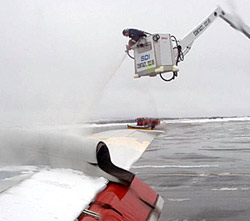 We arrived in St Johns, Newfoundland aboard the NOAA P-3 N43RF
Wednesday (1/20) evening. It was a nice clear evening so weather at
landing was not a problem. The following day brought several inches of
snow and, after a project kick-off meeting at the airport FBO that
morning, we spent the rest of the day working on IWRAP, which had
exhibited some problems during the ferry flight. The problems were
eventually isolated to two bad cable connections and a PCI A/D card that
had worked itself loose over time.
We arrived in St Johns, Newfoundland aboard the NOAA P-3 N43RF
Wednesday (1/20) evening. It was a nice clear evening so weather at
landing was not a problem. The following day brought several inches of
snow and, after a project kick-off meeting at the airport FBO that
morning, we spent the rest of the day working on IWRAP, which had
exhibited some problems during the ferry flight. The problems were
eventually isolated to two bad cable connections and a PCI A/D card that
had worked itself loose over time.


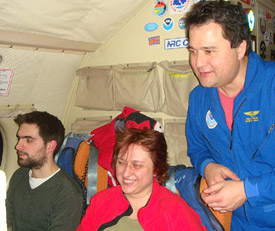
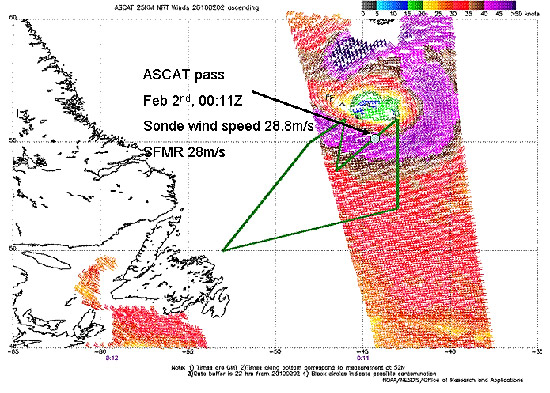
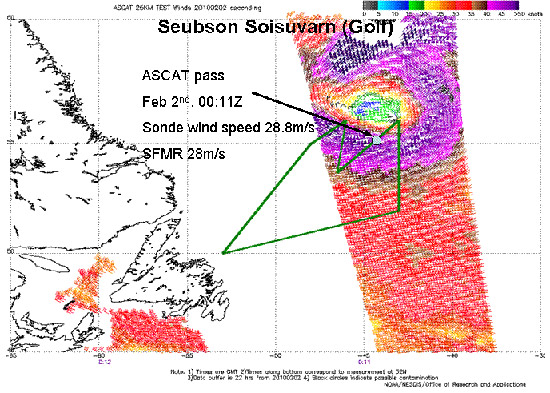
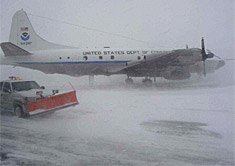
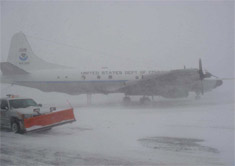
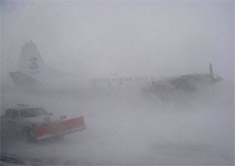
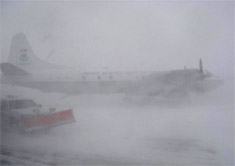
 This is the final update of the Ocean Winds winter 2010 field
experiment. We conducted two consecutive flights Sunday (2/14) and
Monday (2/15) into a predicted hurricane force storm in the Atlantic
south of St. John's. On Sunday the storm was a little further south than
forecast so we weren't able to fully sample the southern portion of the
storm as originally planned. However, we did find marginal hurricane
force winds. One nice thing about this flight was that for the most part
we were free of precipitation and could visually see the ocean surface.
This is the final update of the Ocean Winds winter 2010 field
experiment. We conducted two consecutive flights Sunday (2/14) and
Monday (2/15) into a predicted hurricane force storm in the Atlantic
south of St. John's. On Sunday the storm was a little further south than
forecast so we weren't able to fully sample the southern portion of the
storm as originally planned. However, we did find marginal hurricane
force winds. One nice thing about this flight was that for the most part
we were free of precipitation and could visually see the ocean surface.